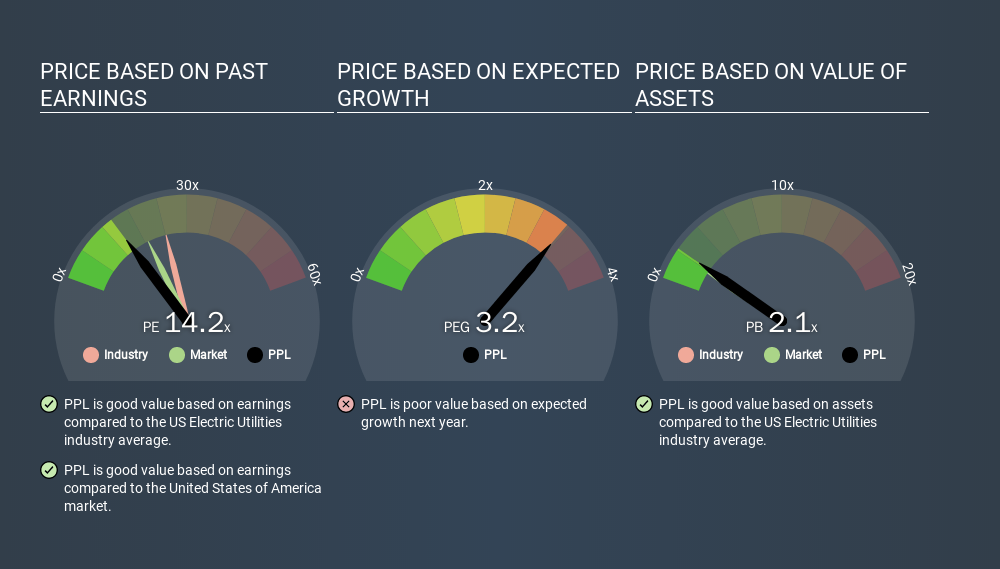- United States
- /
- Electric Utilities
- /
- NYSE:PPL
Does PPL Corporation's (NYSE:PPL) P/E Ratio Signal A Buying Opportunity?
The goal of this article is to teach you how to use price to earnings ratios (P/E ratios). We'll show how you can use PPL Corporation's (NYSE:PPL) P/E ratio to inform your assessment of the investment opportunity. Based on the last twelve months, PPL's P/E ratio is 14.23. That is equivalent to an earnings yield of about 7.0%.
View our latest analysis for PPL
How Do You Calculate PPL's P/E Ratio?
The formula for price to earnings is:
Price to Earnings Ratio = Share Price ÷ Earnings per Share (EPS)
Or for PPL:
P/E of 14.23 = $35.42 ÷ $2.49 (Based on the trailing twelve months to September 2019.)
Is A High P/E Ratio Good?
The higher the P/E ratio, the higher the price tag of a business, relative to its trailing earnings. All else being equal, it's better to pay a low price -- but as Warren Buffett said, 'It's far better to buy a wonderful company at a fair price than a fair company at a wonderful price'.
How Does PPL's P/E Ratio Compare To Its Peers?
The P/E ratio essentially measures market expectations of a company. We can see in the image below that the average P/E (24.2) for companies in the electric utilities industry is higher than PPL's P/E.

PPL's P/E tells us that market participants think it will not fare as well as its peers in the same industry. While current expectations are low, the stock could be undervalued if the situation is better than the market assumes. If you consider the stock interesting, further research is recommended. For example, I often monitor director buying and selling.
How Growth Rates Impact P/E Ratios
When earnings fall, the 'E' decreases, over time. Therefore, even if you pay a low multiple of earnings now, that multiple will become higher in the future. So while a stock may look cheap based on past earnings, it could be expensive based on future earnings.
PPL increased earnings per share by an impressive 17% over the last twelve months. And it has bolstered its earnings per share by 12% per year over the last five years. With that performance, you might expect an above average P/E ratio. In contrast, EPS has decreased by 3.0%, annually, over 3 years.
Remember: P/E Ratios Don't Consider The Balance Sheet
It's important to note that the P/E ratio considers the market capitalization, not the enterprise value. That means it doesn't take debt or cash into account. In theory, a company can lower its future P/E ratio by using cash or debt to invest in growth.
Such expenditure might be good or bad, in the long term, but the point here is that the balance sheet is not reflected by this ratio.
So What Does PPL's Balance Sheet Tell Us?
Net debt totals 87% of PPL's market cap. This is enough debt that you'd have to make some adjustments before using the P/E ratio to compare it to a company with net cash.
The Bottom Line On PPL's P/E Ratio
PPL has a P/E of 14.2. That's below the average in the US market, which is 18.8. While the EPS growth last year was strong, the significant debt levels reduce the number of options available to management. If the company can continue to grow earnings, then the current P/E may be unjustifiably low.
Investors should be looking to buy stocks that the market is wrong about. If it is underestimating a company, investors can make money by buying and holding the shares until the market corrects itself. So this free visualization of the analyst consensus on future earnings could help you make the right decision about whether to buy, sell, or hold.
You might be able to find a better buy than PPL. If you want a selection of possible winners, check out this free list of interesting companies that trade on a P/E below 20 (but have proven they can grow earnings).
If you spot an error that warrants correction, please contact the editor at editorial-team@simplywallst.com. This article by Simply Wall St is general in nature. It does not constitute a recommendation to buy or sell any stock, and does not take account of your objectives, or your financial situation. Simply Wall St has no position in the stocks mentioned.
We aim to bring you long-term focused research analysis driven by fundamental data. Note that our analysis may not factor in the latest price-sensitive company announcements or qualitative material. Thank you for reading.
About NYSE:PPL
PPL
Provides electricity and natural gas to approximately 3.5 million customers in the United States.
Solid track record unattractive dividend payer.
Similar Companies
Market Insights
Community Narratives



